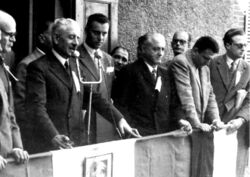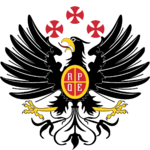Etrurian Third Republic
United Etrurian Federation 3 other official names
| |||||||||
|---|---|---|---|---|---|---|---|---|---|
| 1948–1960 | |||||||||
Motto:
| |||||||||
Anthem:
| |||||||||
| Capital | Povelia | ||||||||
| Demonym(s) | Etrurian | ||||||||
| Government | Federal constitutional presidential republic | ||||||||
| President | |||||||||
• 1948-1950 | Giuseppe Zappella | ||||||||
• 1950-1953 | Mauro Vittore Camillo | ||||||||
• 1953-1957 | Ferdinando Grillo | ||||||||
• 1957-1958 | Andrej Vidmar | ||||||||
• 1958-1960 | Massimo Bartolucci | ||||||||
| Vice President | |||||||||
• 1948-1950 | Mauro Vittore Camillo | ||||||||
• 1950-1953 | Aldo Volpacelli | ||||||||
• 1953-1957 | Leopoldo Aldrovandini | ||||||||
• 1957-1958 | Massimo Bartolucci | ||||||||
• 1958-1960 | Vittore Uccello | ||||||||
| Legislature | Senate | ||||||||
• Upper house | State Council | ||||||||
• Lower house | Chamber of Representatives | ||||||||
| History | |||||||||
| 1 January 1948 | |||||||||
| 4 May 1960 | |||||||||
| Currency | Etrurian florin | ||||||||
| |||||||||
The Etrurian Third Republic (Vespasian: La Terza Repubblica, sometimes written as La 3° Repubblica) was the system of government adopted in Etruria from 1948, when the CN Mandate for Etruria was dissolved upon the formal adoption of the Constitution of Lake Imperia, until 4 May 1960, when the Etrurian Defence Force seized control through a coup d'état.
The Third Republic was formed out of the Constitution of Lake Imperia (Costituzione del Lago Imperia), the governing basic law produced by the two-year CN Mandate for Etruria - which had governed Etruria following its defeat in the Solarian War. The Constitution of Lake Imperia forged a markedly different system to what had been in place since the San Sepulchro Revolution of 1888 (with the exception of the single-party totalitarian state between 1938-1946), with the introduction of a presidential system over the long tradition of a parliamentary system. The two-years of CN government were marred with ideological division among the foreign technocrats and the Etrurian politicians tasked with aiding them, with much division sparked by Etrurian opposition to drastic alterations to its political culture and the CN officials' desire to "consolidate Etrurian democracy" through a highly balanced and separated federal state.
The Republic officially began on 1 January, following the first democratic election since 1926, with a comfortable win by the centrist-liberal Democratic Action, which entered into coalition with the centre-right Sotirian People’s Party, Giuseppe Zappella was elected President by direct-election the same day. Throughout its existence, the Third Republic was hampered by competing branches of government, intense regionalism, institutional corruption and incompetent economic management. The uneven reconstruction of post-war Etruria contributed directly to the Western Emergency and the conflict between the federal government and left-wing nationalist groups in Carinthia and Novalia. The national security crisis, economic stagnation and the widespread moral and social decay of poverty-stricken Etrurian society pushed the military to ultimately seizing power in a bloodless coup on 4 May 1960. The Third Republic ended with the establishment of an authoritarian military government.
The period of the Etrurian Third Republic is subject to continued academic and political debate in Etruria till this day. Many academics following the 4 May Coup, denounced it as a "failed social experiment", while economists have widely reached consensus that the policies and failures of the Third Republic, kept Etruria's economic development at least 20-years behind its neighbours. The often chaotic politics of the Third Republic is also credited for denying Etruria the ability to reconcile with its National Solarianist past, nor the crimes committed during the Solarian War, as well as giving vital space for the preservation of the far-right. In 2020, a poll by Etrurians who lived through the period, showed that over 80% consider it to be a "period of misery and failure."
Establishment
The Third Republic was established after two-years of government by officials from the Community of Nations and Etrurian technocrats. The foundations of the new government were established at the Convention of Lake Imperia, having taken over a year to agree to a constitution, designed to construct and consolidate a vibrant multi-party democracy in Etruria. The new system was designed to ensure that Etruria would never again see a totalitarian dictatorship like the National Solarian regime that sparked the Solarian War. However, the process was not without controversies; with the Etrurian technocrats arguing for a continuation of the historic parliamentary system, against the CN officials who opted for a presidential system, with major checks and balances, and increased powers for the states of the federation. The debate over government system was so fierce that in mid-1947, half of the Etrurian contingent in the CN-government resigned in protest. The CN government under Sean Fitzgerald, simply replaced with them life-long Etrurian liberal reformists who backed the presidential system. As means to accommodate the opposition, the CN provided constitutional amendments such as granting the State Council (the upper-house) the ability to dissolve the Senate for electoral purposes by a two-thirds majority. The historic tradition of powerful parties in the Senate also resulted in the CN introducing proportional representation with an electoral threshold of 15%, guaranteeing a four-party system along traditional ideological lines; the hard-left, centre-left, centre and centre-right.

By November 1947, the constitution was completed and signed collectively by the Convention of Lake Imperia. Despite suggestions from several quarters that the referendum should be put to popular vote through a referendum, this was ultimately rejected by both CN and Etrurian officials, who cited the Mandate’s expiry date being January 1. Historians claim that the lack of a referendum denied the Third Republic the popular legitimacy that may have preserved it, Felice Moro, wrote in 1999, “without a referendum, there was no popular stake, these institutions were not cared for, protected or loved. No Etrurian, bar the 35 who wrote the constitution, had a relationship with the new republic.”
Following the constitution’s signing, the CN organised the first general and presidential election for December. These would be the first elections in Etruria since 1926; with the outbreak of the Great War and the swift seizure of power of the National Solarianists blocking any democratic action. The elections took place without much fanfare, many of the parties competing were legal successors to the pre-ERR parties, with the exception of the United Social Movement, which stood as the successor to the ERR-era Revolutionary Legion of Etruria.
The dual legislative-presidential election was held on December 4, resulting in Giuseppe Zapella’s election as president and his Democratic Action winning the largest number of seats. The Sotirian People’s Party came a close second, with the centre-left, and hard-left following. The USM failed to pass the threshold to gain any seats. The first democratically elected government in Etruria since 1926 took the form of a DA-SPP coalition. The government was formed and prepared by the time the CN officially dissolved its mandate on 1 January 1948, giving way to the United Etrurian Federation.
History
1948-1953
1950-1957
Downfall 1957-1960
Politics
Government
Political parties
Far-right revival
Left-wing nationalism
Western Emergency
Social history
Economy
Foreign policy
Historiography
The Third Republic according to opinion polls and studies since 1984 has consistently and repeatedly be ranked as the worst period of modern Etrurian history, which for non-Etrurian sociologists and historians has sparked significant debate and intrigue, owing to it competing with two period of authoritarian dictatorship (the Greater Solarian Republic and the Military dictatorship). In an in-depth study between 1995 and 1997, researchers from the Euclean University of Kesselbourg found that an overwhelming majority of Etrurian respondents ranked the Third Republic as the lowest point in modern history for seemingly “failing to honour its promise of a democratic and prosperous post-war future.” The resentment appears focused on the economic and political failures of the Third Republic, with many respondents arguing that if the governments had not failed in reconstruction, the Western Emergency would have been avoided and with it, the Junta.
Etrurian scholars have also ranked the Third Republic as one of the greatest failures of Etrurian statecraft and governance. Franco Gugliuzza in his extensive review of the Third Republic wrote in 2004, that the Third Republic essentially condemned Etruria to a loss of two-decades worth of economic development and recovery, a rehabilitated far-right and near fragmentation of the Etrurian nation.
Franco Gugliuzza, The Third Republic: A Failure of Governance
For the first twenty years of the current Fourth Republic, the historiographical view of the Third among Etrurian politicians was fundamentally negative and referenced as an example of "what not to do in government." The centre-left SDP-led coalition under Miloš Vidović (1984-1989) and Vincenzo Biava (1989-1994) regularly compared their efforts to the Third Republic. In 1985, during a speech to lawmakers President Vidović said, “for everyday that our democracy lives, we must forever be conscious of what the Third Republic inflicted upon democracy and the Etrurian people; incompetence, greed, selfishness and the pursuit of ambition over the people, be conscious of this and do the opposite.”
During the various corruption scandals of the late 2000s that endangered both the Social Democratic Party and its allies, fears of the Fourth Republic going the way of the Third became widespread and prominent, both among the political class and general electorate. In 2009, there was a surge in support for far-right political parties at the state-level, resulting the collapse of the SDP-led coalition under President Vinko Begović and the victory of the EFP-SD coalition.
The Miraviglia Scandal at the height of the 2016 EC referendum again drew stark comparisons to the Third Republic, as the scandal decimated the standing of the two traditional parties and their allies. As this led to the collapse of their support and the rapid rise of the far-right neo-nationalist Tribune Movement, the comparisons again were made with greater urgency. In 2017, Gugliuzza wrote, “history now repeats itself. The agents of a promising global and Euclean future succumb to ego and corruption and in their place rises a far-right nightmare ready to devour our institutions and democracy. The curse of the Third Republic lives on.”


